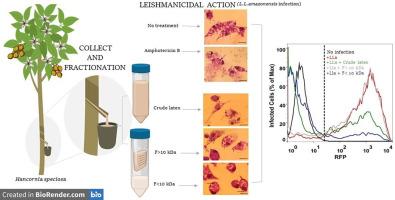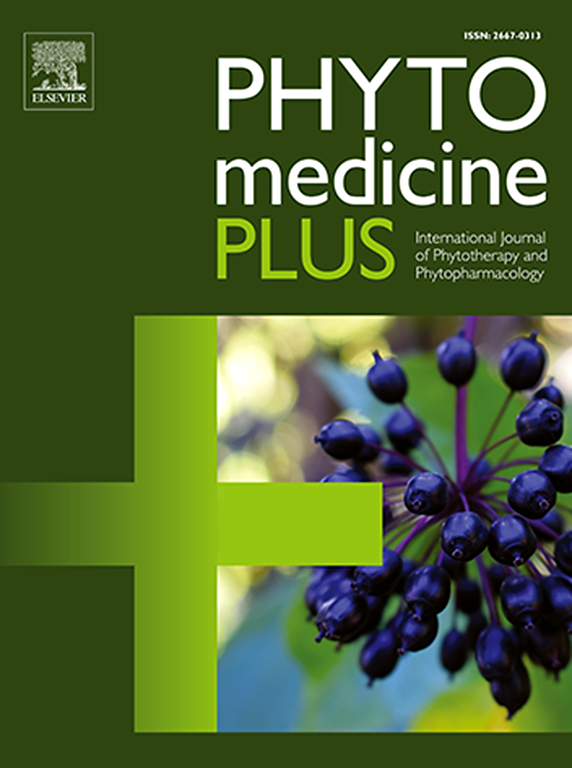In vitro leishmanicidal activity of Hancornia speciosa latex against Leishmania (Leishmania) amazonensis
Q3 Pharmacology, Toxicology and Pharmaceutics
引用次数: 0
Abstract
Background
Leishmaniasis is a neglected tropical disease whose available treatment has limitations. Hancornia speciosa Gomes, a tree native to Brazil, has been studied for its medicinal properties, including antimicrobial and healing properties. However, its effect on parasites of the Leishmania genus still needs to be elucidated.
Purpose
To evaluate the leishmanicidal activity for potential therapeutic use of H. speciosa latex and its fractions on Leishmania (Leishmania) amazonensis promastigotes and amastigotes, as well as to analyze its cytotoxic effects on RAW264.7 cells and murine peritoneal macrophages.
Methods
The anti-promastigote activity of latex and its fractions was evaluated by cell viability assays via MTT in L. (L.) amazonensis and monitoring the parasite's growth kinetics by counting under light microscopy. To evaluate anti-amastigote activity, RAW264.7 cells and murine peritoneal macrophages infected with amastigotes were analyzed using microscopy, immunofluorescence, and flow cytometry assays. The cytotoxicity of latex and its fractions was evaluated in these cells via MTT assay.
Results
The H. speciosa latex and its fractions showed anti-promastigote activities in L. (L.) amazonensis, reducing its proliferation and viability and altering its morphology. These did not interfere with the viability of RAW264.7 cells and peritoneal macrophages. Crude latex and F < 10 kDa at 5 % reduced the infection of intracellular amastigotes in peritoneal macrophages to 32 % and 18 % after 24 h of treatment, respectively. Under the same conditions, the F > 10 kDa fraction showed 82 % of infected cells. The evaluation of the latex composition showed that the F > 10 kDa fraction has the highest concentration of carbohydrates, followed by phenolic compounds and proteins. In contrast, the F < 10k Da fraction presented fewer phenolic compounds and carbohydrates.
Conclusions
These results indicate that H. speciosa crude latex and F < 10 kDa have intense leishmanicidal activity against L. (L.) amazonensis promastigotes and amastigotes internalized by macrophages. Additionally, the lack of cytotoxicity indicates that H. speciosa latex is a strong candidate for new alternative treatments for leishmaniasis.

大叶黄杨胶乳对亚马逊利什曼原虫的体外杀利什曼活性
背景利什曼病是一种被忽视的热带疾病,其现有治疗方法存在局限性。Hancornia speciosa Gomes 是一种原产于巴西的树木,其药用特性包括抗菌和治疗特性已被研究过。目的 评估 H. speciosa 胶乳及其馏分对亚马逊利什曼原虫和非原虫的杀利什曼活性,并分析其对 RAW264.方法通过 MTT 检测亚马逊利什曼原虫的细胞存活率,并在光镜下计数监测寄生虫的生长动力学,来评估乳胶及其馏分的抗原虫活性。为了评估抗变形虫活性,使用显微镜、免疫荧光和流式细胞术分析了感染了变形虫的 RAW264.7 细胞和小鼠腹腔巨噬细胞。结果H. speciosa 胶乳及其馏分对 L. (L. )amazonensis 有抗原体活性,能降低其增殖和存活率并改变其形态。这些物质不会干扰 RAW264.7 细胞和腹腔巨噬细胞的活力。处理 24 小时后,粗乳胶和 5 % 的 F < 10 kDa 可分别将腹腔巨噬细胞内的变形虫感染率降至 32 % 和 18 %。在相同条件下,F > 10 kDa 部分的细胞感染率为 82%。对胶乳成分的评估显示,F > 10 kDa 部分的碳水化合物含量最高,其次是酚类化合物和蛋白质。结论这些结果表明,H. speciosa 粗胶乳和 F < 10 kDa 对巨噬细胞内化的亚马逊原虫和非原虫具有很强的杀利什曼活性。此外,H. speciosa胶乳缺乏细胞毒性,这表明它是利什曼病新替代疗法的有力候选者。
本文章由计算机程序翻译,如有差异,请以英文原文为准。
求助全文
约1分钟内获得全文
求助全文
来源期刊

Phytomedicine Plus
Medicine-Complementary and Alternative Medicine
CiteScore
3.70
自引率
0.00%
发文量
178
审稿时长
81 days
期刊介绍:
 求助内容:
求助内容: 应助结果提醒方式:
应助结果提醒方式:


